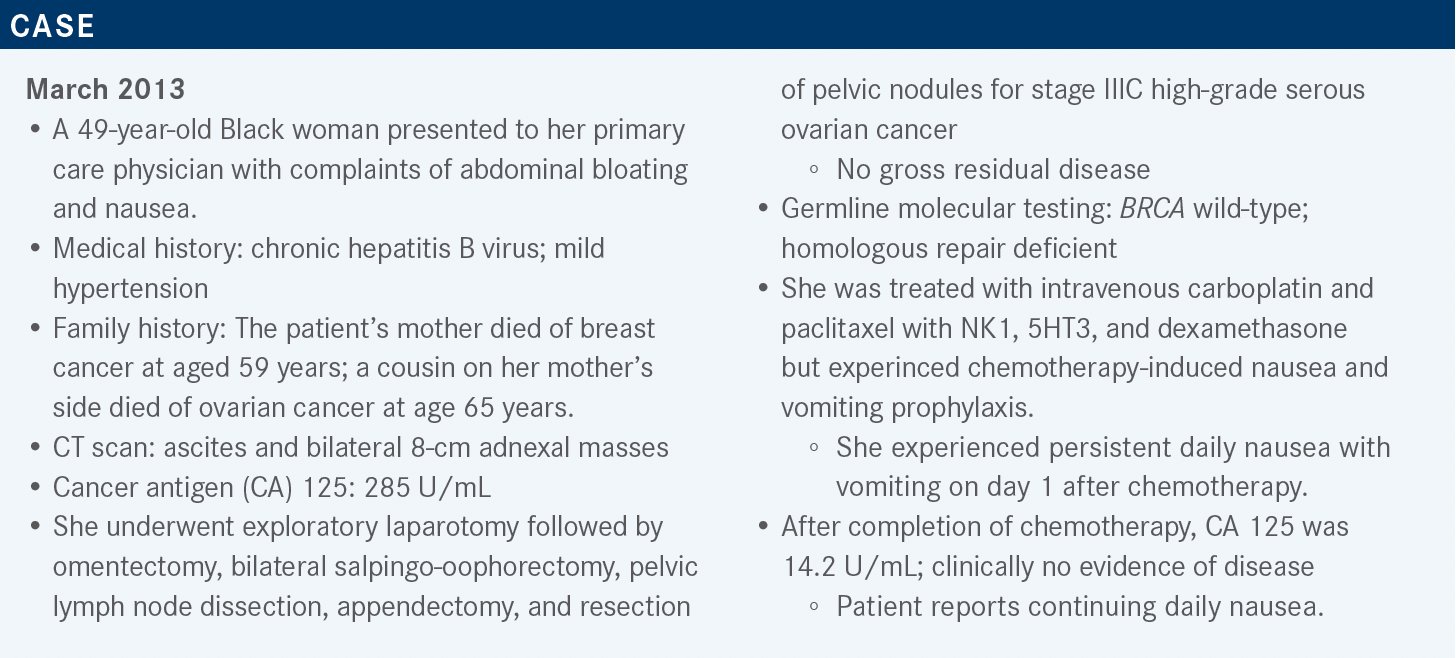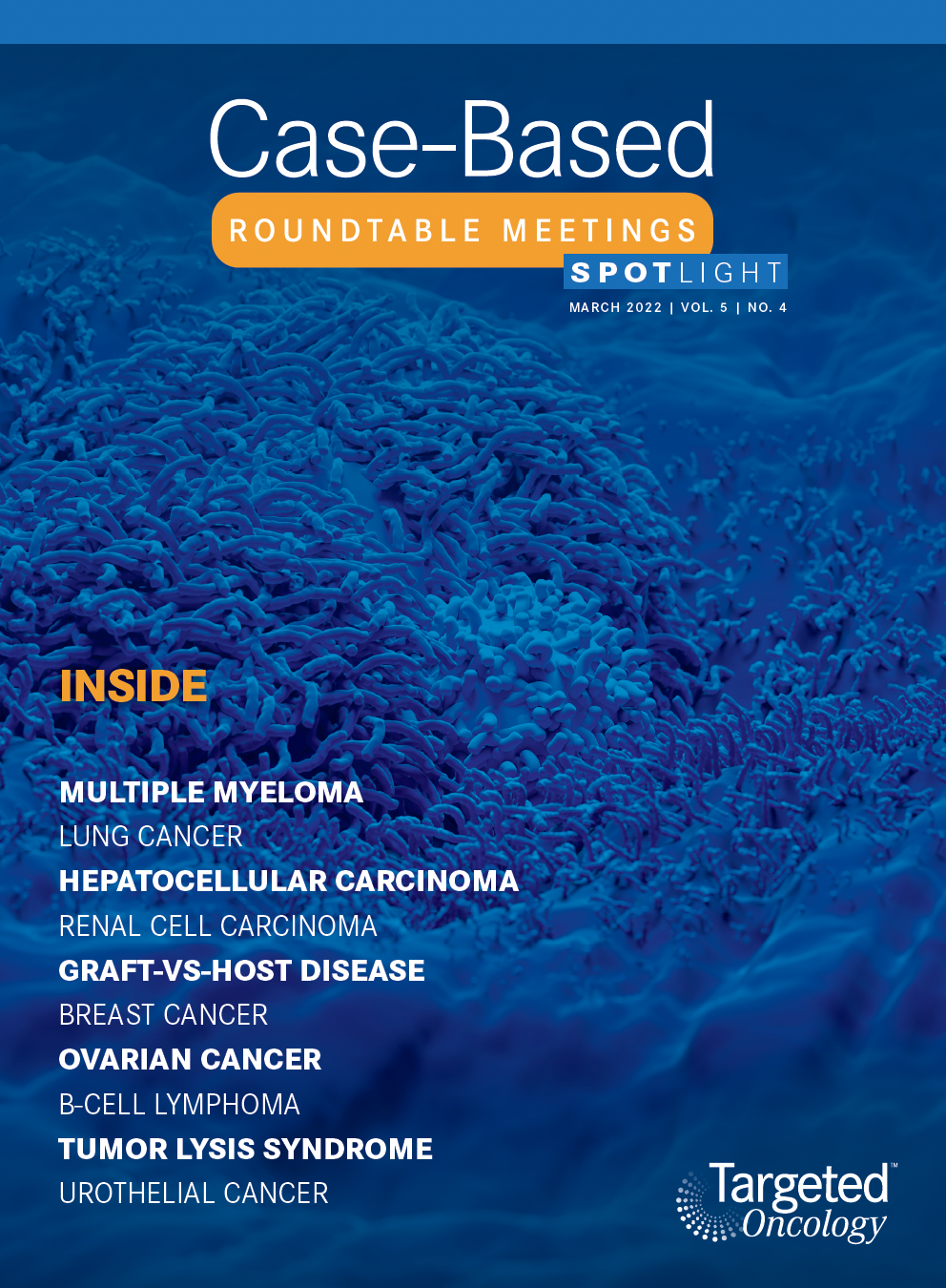Crane Explores the Options for Maintenance Therapy in Advanced Ovarian Cancer
During a Targeted Oncology case-based roundtable event, Erin Crane, MD, MPH, discussed several phase 3 trials of new combinations for maintenance therapy of advanced ovarian cancer.

Erin Crane, MD, MPH
Gynecologic Oncologist
Atrium Health Levine Cancer Institute
Charlotte, NC

Targeted OncologyTM: What phase 3 trials have addressed first-line maintenance after platinum-based therapy for patients with advanced ovarian cancer?
CRANE: The GOG-0218 trial [NCT00262847] examined maintenance with bevacizumab [Avastin] plus carboplatin and paclitaxel vs maintenance with carboplatin and paclitaxel alone. We can’t talk about maintenance therapy and ignore this trial. In this trial, the key patient population was all comers, and they were treated for 15 months with bevacizumab maintenance. There was about a 3-month improvement in progression-free survival [PFS].1-3 The duration of bevacizumab maintenance in [the GOG-0218] trial is the duration that, as physicians, we generally use, and this [serves as] important background for some of the other trials, specifically PAOLA-1 [NCT02477644].4
There are 3 trials that looked at maintenance with PARP-targeted therapies: SOLO-1 [NCT01844986],5,6 PRIMA [NCT02655016],7,8 and PAOLA-1.4,6 These phase 3 trials had different patient populations and different study drugs.
The SOLO-1 trial compared olaparib [Lynparza] with placebo in the frontline maintenance setting after chemotherapy. In this trial, patients had to have a germline or somatic BRCA mutation and high-grade serous or endometrioid adenocarcinoma. Patients had [previously achieved] a complete or partial response to first-line platinum therapy and in this trial were randomized in a 2:1 fashion to receive either olaparib at 300 mg twice a day or placebo. Duration of treatment with olaparib was 25 months, or about 2 years. The primary end point was investigator-assessed PFS.5 The FDA’s first-line maintenance indication [for this drug] is not all comers,9 because the trial only looked at patients with either germline or somatic tumor BRCA mutations.5
The PRIMA trial looked at niraparib [Zejula] maintenance in the first-line setting. This study had a slightly more unfavorable population, with patients at high risk for progressive disease with stage III or IV cancer. This study included all comers, so patients did not have to have a BRCA mutation, [though] the study did look at homologous recombination deficiency [HRD]. These patients [were required to have had] either a complete or partial response to first-line platinum treatment. The patients were stratified according to whether they had received neoadjuvant chemotherapy, the type of response they had to chemotherapy, complete or partial, and whether they were positive or negative for HRD. Patients were randomized in a 2:1 fashion to receive niraparib [300 mg once a day] or placebo. Patients were treated until disease progression or to 3 years—a longer duration of treatment. The primary end point was PFS.7
The PAOLA-1 trial was conducted with patients who had completed first-line platinum-based chemotherapy.10,11 Again, the key patient population was all comers; patients didn’t have to have BRCA mutations or HRD. Patients were randomly assigned to receive maintenance either with bevacizumab plus olaparib or with bevacizumab plus placebo.
The duration of treatment was 15 months for bevacizumab and 24 months for olaparib.4 Some of us have raised issues with this trial because there was no olaparib-only arm, but it is an interesting study. Both PAOLA-1 and PRIMA resulted in FDA approval for patients who have had a complete or partial response to first-line platinum-based treatment.12,13 In the case of PAOLA-1, approval was for patients who are HRD positive or who have genomic instability.12
In those trials, how did patients in the overall population fare with respect to PFS?
In the SOLO-1 trial, there was an astronomical difference in PFS between patients who received olaparib vs those who received placebo [56.0 months vs 13.8 months, respectively; HR, 0.33; 95% CI, 0.25-0.43].5,14 Keep in mind that these were all patients who had BRCA mutations, so we know that these patients are going to have a better overall prognosis and response to treatment.
In the PRIMA trial, there was about a 5-month improvement in PFS among all comers who received niraparib compared with those who received placebo, 13.8 months vs 8.2 months, respectively [HR, 0.62; 95% CI, 0.50- 0.76; P < .001]. But among patients with BRCA mutations, there was an increased magnitude of improvement: 21.9 months vs 10.4 months, respectively [HR, 0.43; 95% CI, 0.31-0.59].7
In the PAOLA-1 trial, PFS was 22.1 months among all comers who received bevacizumab plus olaparib vs 16.6 months among those who received bevacizumab plus placebo [HR, 0.59; 95% CI, 0.49-0.72], an improvement of about 6 months.4
The National Comprehensive Care Network [NCCN] guidelines now incorporate all these trials into their recommendations.15
Can you elaborate on the results of the SOLO-1 trial of olaparib?
When these results were first presented, there were gasps in the audience. We started to think, “Hey, maybe we’re actually curing patients of their cancer.” At 24 months, the Kaplan-Meier curves are separated; this is the 2-year mark at which we say, “Well, maybe this [cancer] isn’t coming back.” In continuation up to 60 months, the curves remain separated.14 There was an incredible HR as well; we almost never see that for ovarian cancer.
When we do these trials, we try to determine whether any particular subgroup benefited more or less than others. This study’s subgroup analysis showed that all patients benefited [from olaparib treatment]. This was true regardless of the patients’ BRCA1 and BRCA2 mutation status, their disease stage, and their response to chemotherapy— complete or partial.5
The main adverse events [AEs] were cytopenias: thrombocytopenia, anemia, and neutropenia. There were some other AEs, like nausea, fatigue, and constipation. It’s important to note that a [meaningful] proportion of patients in the placebo group had AEs as well. We have to remember that these patients had received 6 cycles of chemotherapy, and many of them were still tired and nauseated from that treatment.5,14 That does [affect patients who are] started on PARP maintenance.
What other details can you share about the PRIMA trial of niraparib?
In this trial, a large proportion of patients [about a third] had stage IV disease, and a large proportion— over half—had received neoadjuvant chemotherapy. This more unfavorable population really [precludes] cross-trial comparisons [with SOLO-1 and PAOLA-1].4,5,7,16
The subgroup analysis was interesting. It’s important to remember that the FDA has approved niraparib maintenance for anyone who has had a complete or partial response after first-line therapy, regardless of HRD status.13 In patients who had BRCA mutations and HRD, there was a median PFS of 22.1 months in the experimental arm and 10.09 months in the control arm [HR, 0.40; 95% CI, 0.27-0.62; P < .001]. As you would expect, this subgroup experienced the largest magnitude of benefit in response to niraparib treatment.7
Patients who did not have germline BRCA mutations but who did have HRD, the inherited somatic defect in DNA repair, still experienced a large magnitude of benefit: 19.6 months in the experimental arm vs 8.2 months in the placebo arm [HR, 0.50; 95% CI, 0.31-0.83; P = .006]. [In contrast], patients who were negative for HRD experienced a benefit of much smaller magnitude: 8.1 months in the experimental arm vs 5.4 months in the control arm [HR, 0.68; 95% CI, 0.49- 0.94; P = .020].7 This result [prompted discussion about whether we should] offer somatic testing to all patients or offer niraparib maintenance to all patients regardless of HRD status.
Subgroup analysis revealed that pretty much all comers experienced some magnitude of benefit favoring niraparib over placebo. This included subgroups defined by disease stage and defined by whether patients had received neoadjuvant chemotherapy.7
Interim analysis of overall survival [suggests that] niraparib is favored over placebo, but the overall survival event rates are low. In other words, there haven’t been that many deaths yet, so we can’t draw any definitive conclusions; that will be presented at a future meeting.17
Treatment-related AEs were manageable and consistent with the PARP inhibitor class. As expected, a higher proportion of patients on treatment than of those on placebo experienced thrombocytopenia, anemia, neutropenia, nausea, fatigue, and constipation.18 But similar to what was observed in the SOLO-1 trial,5,14 a [meaningful] proportion of patients who received placebo after completing chemotherapy were tired after that treatment and had some AEs.18 [For example], 1 patient had myelodysplastic syndrome after 9 months of niraparib treatment. That is why we continue to monitor these patients very closely.
Can you discuss more about the results of the PAOLA-1 trial of bevacizumab plus olaparib?
In this study, the percentage of patients exhibiting PFS at 12 months, at 18 months, and at 24 months was consistently greater in the bevacizumab plus olaparib group than in the control group, [at 24 months, 46% vs 28%, respectively].4
There was a greater magnitude of benefit observed among patients who had BRCA mutations [in the experimental and control arms, 37.2 months vs 17.7 months, respectively; HR, 0.33; 95% CI, 0.25-0.45]. Among patients who did not have BRCA mutations but who were HRD positive, PFS was 28.1 months vs 16.6 months, respectively [HR, 0.43; 95% CI, 0.28-0.66]. Patients who did not have BRCA mutations and who were HRD negative did not have as much benefit, only 16.6 months vs 16.0 months, respectively [HR, 0.92; 95% CI, 0.72-1.17].4
There weren’t any surprises in terms of AEs. The AEs included some hypertension and proteinuria,4 [which are associated with bevacizumab],3 and cytopenias,4 caused by olaparib.6
What dosage guidance exists for physicians using niraparib or olaparib?
During an interim analysis in the PRIMA study of niraparib, it was noted that patients with a body weight less than 77 kg or with a starting platelet count less than 150,000/μL often required a dose reduction or interruption. So about halfway through the study, the dosing was changed so that such patients started on a once-daily dose of 200 mg. I’ve had to dose reduce, and patients worry that it’s less effective. However, an exploratory analysis suggested that there was still a significant PFS benefit to HRD-positive patients [HR, 0.39; 95% CI, 0.22-0.72] and to the overall patient population [HR, 0.68; 95% CI, 0.48- 0.97]. It is recommended to start niraparib maintenance no later than 12 weeks after completion of the most recent platinum-containing regimen, which is plenty of time.8,19 I would say that if a patient hasn’t recovered from their hematologic toxicities, or other toxicities, at the 3-month mark, then they’re probably not the best candidate for PARP maintenance anyway.
For both niraparib and olaparib, dose adjustments can be made for AEs. With olaparib, in general, the starting dose is 300 mg twice a day. The first dose reduction is to 250 mg twice a day, and the second reduction is to 200 mg twice a day. It’s a little more complicated [because] the pills come in different strengths.6 It’s a little easier to dose reduce with niraparib, because it comes in 100-mg capsules, and each dose reduction is a 100-mg reduction. The starting dose is either 300 mg or 200 mg, based on body weight and platelet count.8
What does the American Society of Clinical Oncology (ASCO) recommend in regard to germline and somatic testing in epithelial ovarian cancer?
The ASCO guidelines have a lot of information. Basically, we know that anyone who has epithelial ovarian, fallopian tube, or primary peritoneal carcinoma should be offered germline BRCA1 and BRCA2 testing and even expanded panel testing.20
For patients who don’t carry a germline pathogenic [or likely pathogenic] variant of BRCA1 or BRCA2, ASCO recommends somatic tumor testing to see whether or not those patients are candidates for maintenance with olaparib or other PARP inhibitors,6,20,21 mainly because of the SOLO-1 trial.5 Anyone who is a first- or second-degree relative of a patient with ovarian cancer should be offered genetic testing.20,21 We refer patients to our genetic counselors; I think most institutions have genetic counselors at this point.
What genetic testing guidelines does the NCCN recommend?
The NCCN’s recommendations for tumor molecular analysis include next-generation testing for BRCA1 and BRCA2 mutations and other somatic mutations; for example, the NTRK gene fusions, which are rare. They say that, in addition to BRCA1 and BRCA2 testing, other methods to evaluate homologous recombination status may be considered. The NCCN also recommends testing for mismatch repair proteins because a small set of patients with ovarian cancer will have Lynch syndrome [and testing for microsatellite instability]. Finally, according to the NCCN, additional somatic tumor testing can be done at the physician’s discretion.12
REFERENCES
1. Burger RA, Brady MF, Bookman MA, et al. Incorporation of bevacizumab in the primary treatment of ovarian cancer. N Engl J Med. 2011;365(26):2473-2483. doi:10.1056/NEJMoa1104390
2. Norquist BM, Brady MF, Harrell MI, et al. Mutations in homologous recombination genes and outcomes in ovarian carcinoma patients in GOG 218: an NRG Oncology/Gynecologic Oncology Group study. Clin Cancer Res. 2018;24(4):777- 783. doi:10.1158/1078-0432.CCR-17-1327
3. Avastin. Prescribing information. Genentech; 2021. Accessed February 9, 2022. https://bit.ly/3oSEqQo
4. Ray-Coquard I, Pautier P, Pignata S, et al; PAOLA-1 Investigators. Olaparib plus bevacizumab as first-line maintenance in ovarian cancer. N Engl J Med. 2019;381(25):2416-2428. doi:10.1056/NEJMoa1911361
5. Moore K, Colombo N, Scambia G, et al. Maintenance olaparib in patients with newly diagnosed advanced ovarian cancer. N Engl J Med. 2018;379(26):2495- 2505. doi:10.1056/NEJMoa1810858
6. Lynparza. Prescribing information. AstraZeneca; 2022. Accessed February 11, 2022. https://bit.ly/3HXvxfU
7. González-Martín A, Pothuri B, Vergote I, et al; PRIMA/ENGOT-OV26/GOG-3012 Investigators. Niraparib in patients with newly diagnosed advanced ovarian cancer. N Engl J Med. 2019;381(25):2391-2402. doi:10.1056/NEJMoa1910962
8. Zejula. Prescribing information. GlaxoSmithKline; 2021. Accessed February 11, 2022. https://bit.ly/3sIZ9ap
9. FDA approved olaparib (Lynparza, AstraZeneca Pharmaceuticals LP) for the maintenance treatment of adult patients with deleterious or suspected deleterious germline or somatic BRCA-mutated (gBRCAm or sBRCAm) advanced epithelial ovarian, fallopian tube or primary peritoneal cancer who are in complete or partial response to first-line platinum-based. FDA. Updated December 26, 2018. Accessed February 11, 2022. https://bit.ly/3GVOGxt
10. Platine, Avastin, and OLAparib in 1st line (PAOLA-1). ClinicalTrials.gov. Updated February 4, 2022. Accessed February 11, 2022. https://bit.ly/3BpYXkc
11. PAOLA-1 Study. Accessed February 11, 2022. https://bit.ly/367eRV1
12. FDA approves olaparib plus bevacizumab as maintenance treatment for ovarian, fallopian tube, or primary peritoneal cancers. FDA. Updated May 11, 2020. Accessed February 11, 2022. https://bit.ly/3BoyFie
13. FDA approves niraparib for first-line maintenance of advanced ovarian cancer. FDA. April 29, 2020. Accessed February 11, 2022. https://bit.ly/3GVfVrG
14. Banerjee S, Moore KN, Colombo N, et al. Maintenance olaparib for patients (pts) with newly diagnosed, advanced ovarian cancer (OC) and a BRCA mutation (BRCAm): 5-year (y) follow-up (f/u) from SOLO1. Ann Oncol. 2020;31(suppl 4):S613. doi:10.1016/j.annonc.2020.08.950
15. NCCN. Clinical Practice Guidelines in Oncology. Ovarian cancer including fallopian tube cancer and primary peritoneal cancer, version 1.2022. Accessed February 9, 2022. https://bit.ly/3JyFUHc
16. Monk BJ, González-Martín A. Efficacy of niraparib therapy in patients with newly diagnosed advanced ovarian cancer by BRCA and homologous recombination status: PRIMA/ENGOT-OV26/GOG-3012 study. Presented at: Society of Gynecologic Oncology 2020 Annual Meeting on Women’s Cancer; March 27-31, 2020; Toronto, ON, Canada. Accessed February 11, 2022. https://bit. ly/3JOLhCz
17. Han SN, Monk BJ, González-Martín A. Time to first subsequent therapy (TFST) and progression-free survival 2 (PFS2) from the phase 3 randomized, double-blind PRIMA/ENGOT-OV26/GOG-3012 study in patients with newly diagnosed ovarian cancer. Presented at: Society of Gynecologic Oncology 2020 Annual Meeting on Women’s Cancer; March 27-31, 2020; Toronto, ON, Canada. Accessed February 11, 2022. https://bit.ly/3oQ8fBa
18. González-Martín A, Pothuri B, Vergote IB, et al. Niraparib therapy in patients with newly diagnosed advanced ovarian cancer (PRIMA/ENGOT-OV26/ GOG-3012 study). Presented at: European Society for Medical Oncology 2019 Congress; September 27-October 1, 2019; Barcelona, Spain. Accessed February 11, 2022. https://bit.ly/33p6Mdo
19. Berek JS, Matulonis UA, Peen U, et al. Safety and dose modification for patients receiving niraparib. Ann Oncol. 2018;29(8):1784-1792. doi:10.1093/ annonc/mdy181
20. Gynecologic cancer. Germline and somatic tumor testing in epithelial ovarian cancer. American Society of Clinical Oncology. January 27, 2020. Accessed February 11, 2022. https://bit.ly/3LxbMOi
21. Konstantinopoulos PA, Norquist B, Lacchetti C, et al. Germline and somatic tumor testing in epithelial ovarian cancer: ASCO guideline. J Clin Oncol. 2020;38(11):1222-1245. doi:10.1200/JCO.19.02960

















